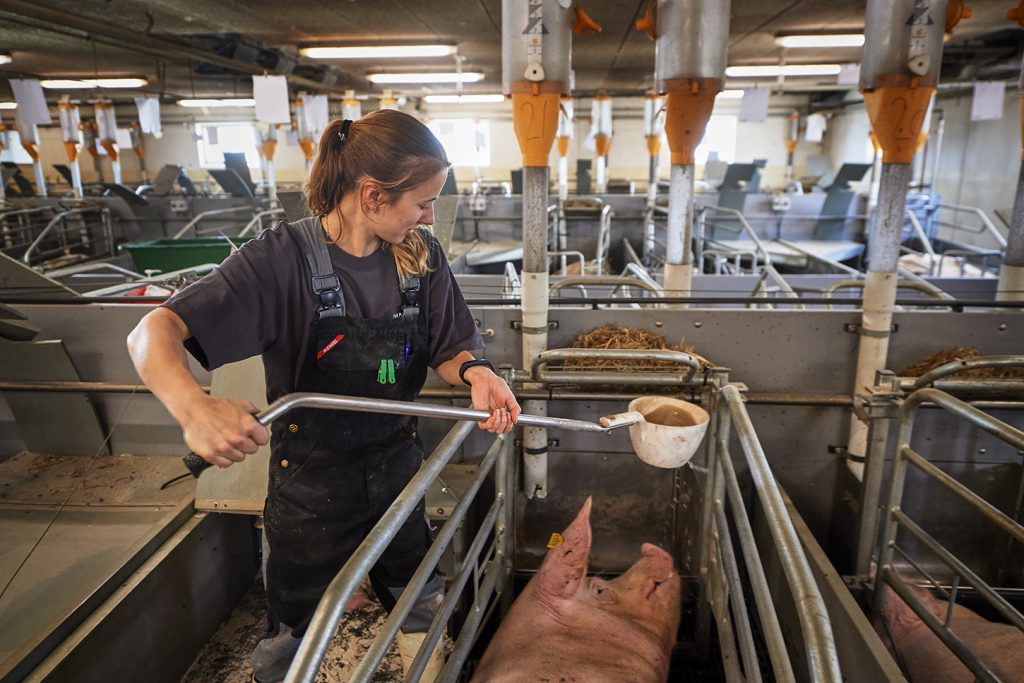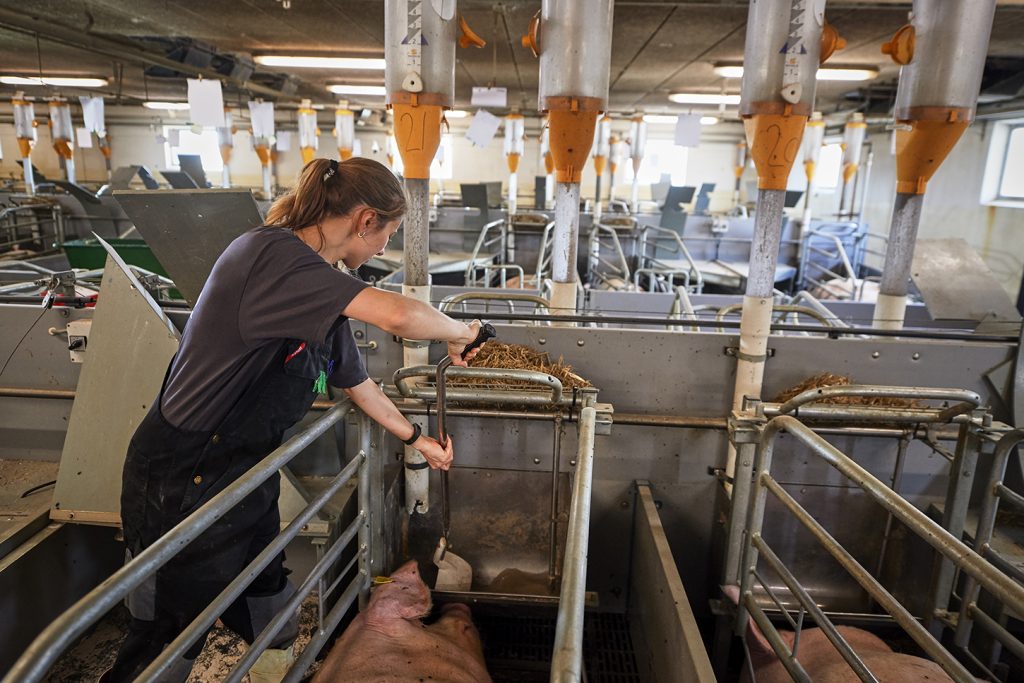Feeding lactating sows
Careful attention feeding during lactation is vital to reach the full potential for maximising piglet growth. Furthermore, feeding throughout lactation must ensure that weight loss does not exceed a level where it influences optimum wean-to-service interval as well as litter size in subsequent litters. The DanBred sow is very robust, and lactational weight loss from 5-20 kg does not affect subsequent lactation, however, a high degree of mobilisation will require subsequent restorage.
Proper feeding of the lactating sow will ensure optimum conditions and development of the piglets during the lactation period, as feeding affects the condition and productivity of the sow. Through the lactation period, it is necessary to adjust the feed intake to minimize weight loss in the sow and secure productivity in subsequent litters. The sow will take care of the piglets and ensure the development of the piglets; however, we need to ensure that the sows are not compromised in the process.
During the lactation period, it is necessary to adjust feed intake to optimise milk production as well as maintain the best body condition possible.
Production targets
- Ensuring a successful farrowing and efficient onset of lactation
- Support high milk yield to maximise the number of nursing piglets
- Maintain an average body condition throughout lactation
- Keep sows between 12 – 14 mm backfat at weaning
Body condition & Weight
Feeding during lactation should ensure that 90% of the lactating sows at all times can be categorized as average in a body condition evaluation. The best way to determine body condition score is to measure backfat.
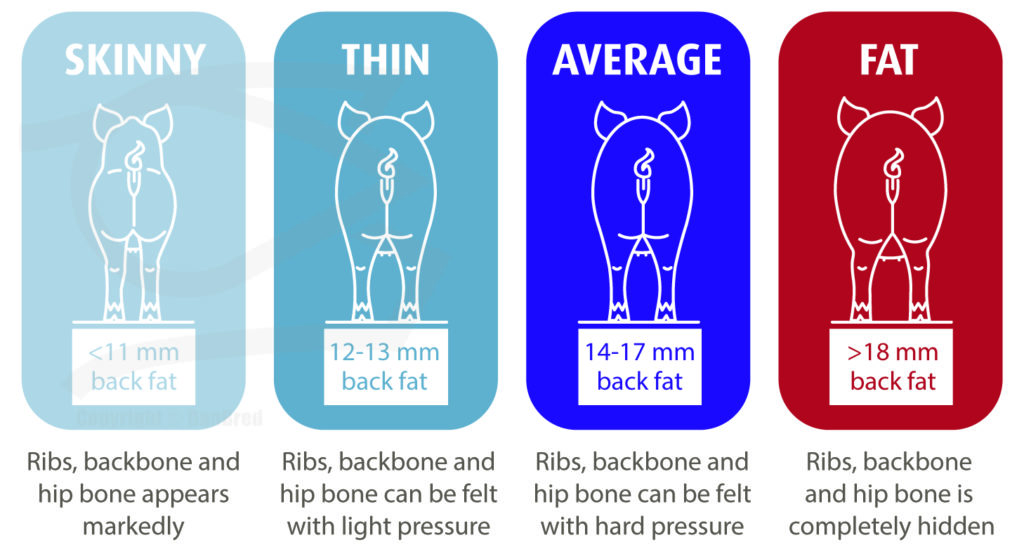
* Backfat target at the time of weaning/mating, and measured at the point P2.
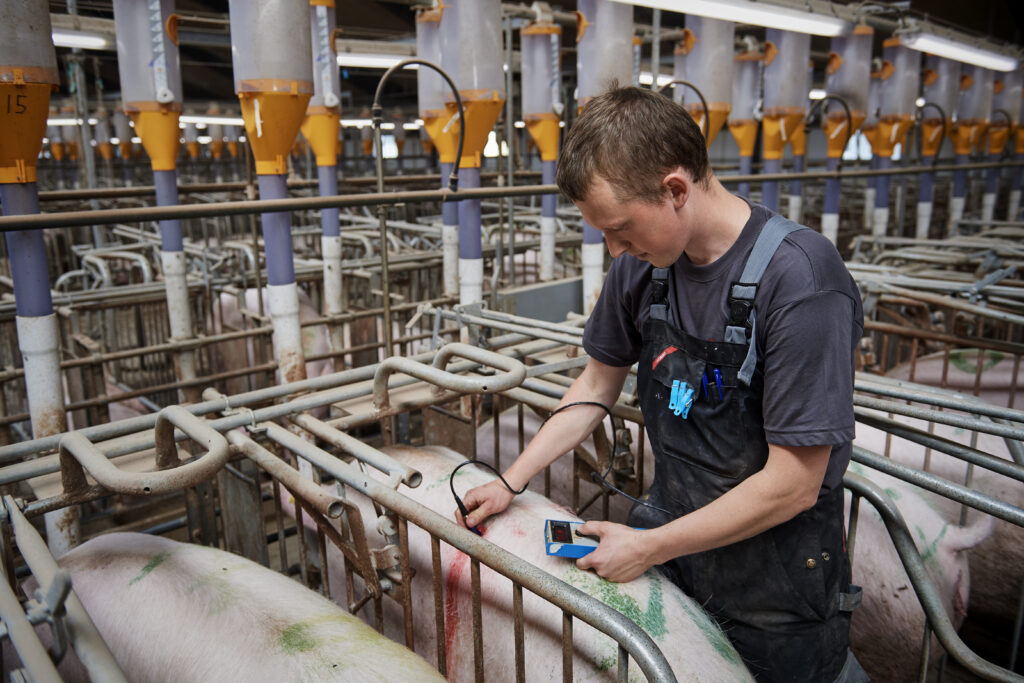 |
 |
Water for lactating sows
The greatest component in sow milk is water, why it is important to ensure that sows constantly have free access to fresh water.
It is estimated that sows need a water intake of 25 to 50 litres per day when milk production peaks approximately 16-18 days into lactation.
Check the flow rate for all drinkers frequently and ensure a minimum flow of 4 litres/ minute when 20% of the sows are using the nipples/drinkers.
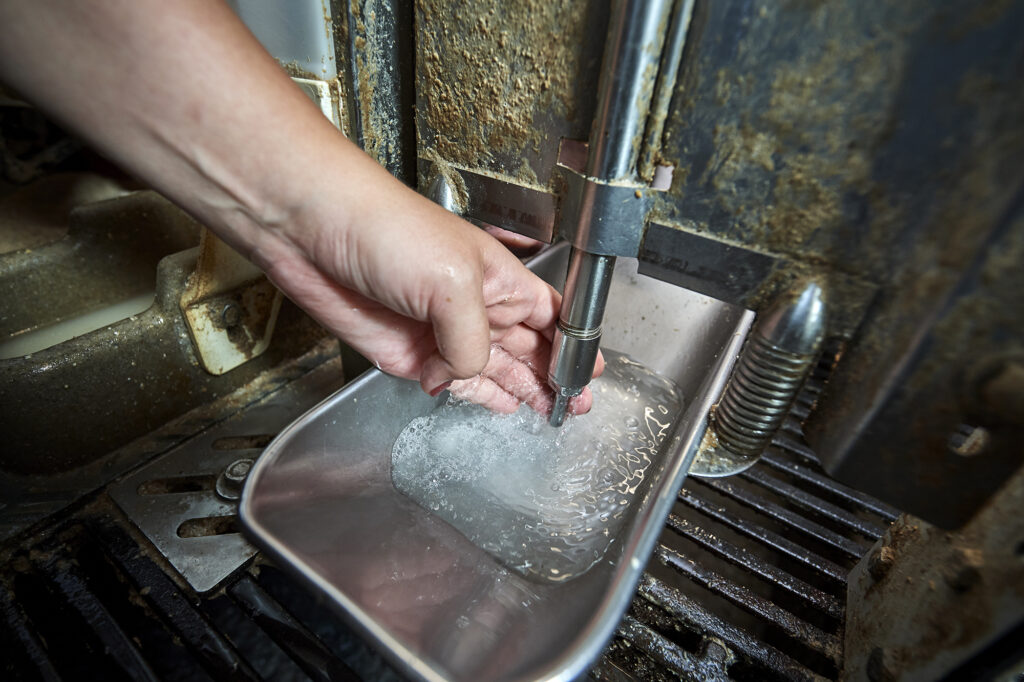
Nutrient requirements
The basic nutritional requirements for DanBred sows are described below. The requirements are based on production in a temperate zone, adaption for the relevant climate may be necessary.
| Energy, per kg feed | Normal energy density | High energy density | ||
|---|---|---|---|---|
| MJ ME/kg feed | 13.1 | 13.8 | ||
| MJ NE/kg feed | 9.9 | 10.5 | ||
| Danish Feed Units (FU) sow/kg | 1.07 | 1.13 | ||
| Relations between MJ ME/MJ NE are depending on feed ingredients | ||||
| Basic nutrients, digestible per kg | ||||
| SID protein. min. g/kg | 125 | 134 | ||
| Lysine, SID g/kg | 8.2 | 8.7 | ||
| Digestible phosphorus g/kg | 3.2 | 3.4 | ||
| Calcium, g/kg | 8.5 | 9.0 | ||
| For corn-soy based diets please see nutrient recommendations here. | ||||
Mineral and vitamin supply should be adequate to ensure optimal litter development and general health. Soluble, as well as insoluble fibres, should be added to maintain gut health.
The full nutrient tables can be found here.
Feeding strategy
At entry in the farrowing unit, the recommendation is to give sows in average body condition around 3.4 kg per day.
One or 2 days before expected the feed allowance is reduced to around 3 kg per day. However, recent research has shown that keeping the feeding level at 3.4-3.8 kg/day for sows older than second parity can improve the farrowing performance and reduce the need of farrowing assistance.
The recommendation is to feed the sows at least three times a day with an interval of eight to 10 hours, this will ensure a steady energy supply which has been shown to shorten the length of the farrowing.
Daily feed adjustments
Good feed intake is the key to high litter gain and controlled mobilisation of the sow, why it is important to notice if all sows are eating well every day.
Let the sows follow a feed curve where daily adjustments are made for sows which are eating their full ration. In the first week to 10 days of lactation, feed allowance should gradually increase by 0.2 – 0.5 kg per day.
Adjustments to the feed curve should follow the individual sows’ actual feed consumption, why only sows who have emptied their troughs should be adjusted daily.
| Days post farrowing | Minimum feed allowance (kg per day)1,2 |
Aim for feed allowance (kg per day)1,2 |
|---|---|---|
| 0 | 2.9 | 2.9 |
| 2 | 3.3 | 3.7 |
| 7 | 4.7 | 6.0 |
| 14 | 7.0 | 8.5 |
| 16 | 7.5 | 9.0 |
| 18 | 8.0 | 9.0 |
| 21 | 8.0 | 9.0 |
| 28 | 8.0 | 9.0 |
| 35 | 8.0 | 9.0 |
1 Feeding curves serve as a guideline, and feed should be adjusted individually for each sow. Using daily corrections in liquid feeding for sows is recommended, and in early lactation, an additional 8-10 % increase in feed allowance is recommended for sows with high litter size and good appetite. From day 10-14 onwards an increase of 2-4% each day is an adequate increase in feed allowance. The exact same recommendations can be used when using dry feed for lactating sows
2 The feeding curve is based on lactation feed with an energy concentration of 9.8 MJ NE/13.0 MJ ME/1.06 EW per kg feed and containing 8.3 g SID lysine per kg feed equivalent to 9.4 g total lysine per kg feed.
* For sows nursing ≥14 piglets the targeted feed allowance should be 5-8 % higher.
In practice, it can be an advantage to let the same person do the adjustments after the same feeding every day. Adjust before the troughs are cleaned, and optimally about 30 minutes after a feeding.
 |
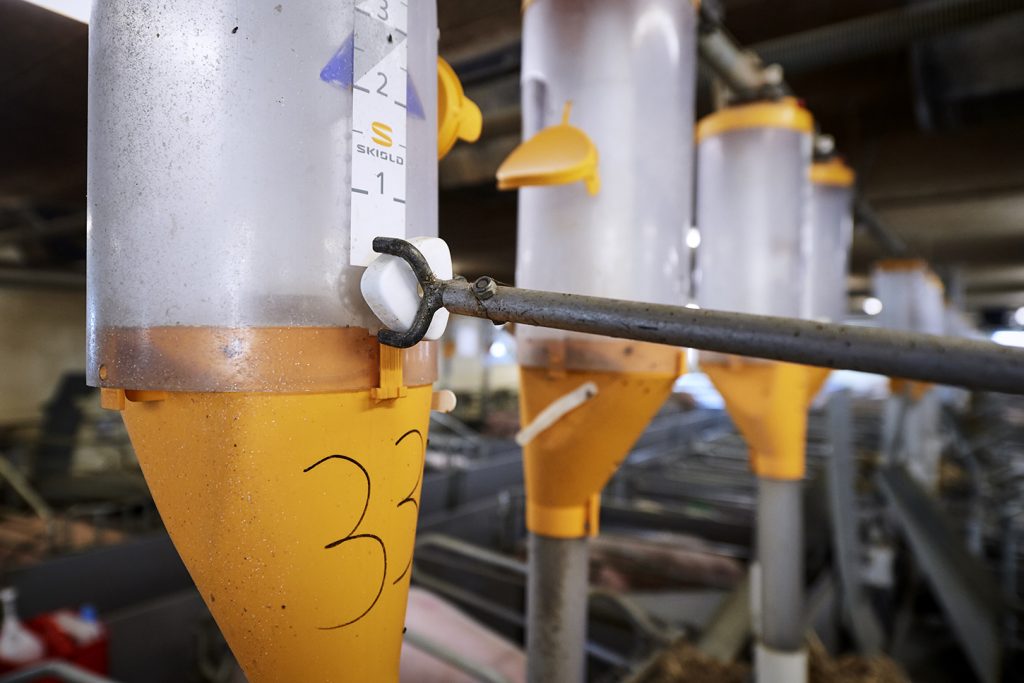 |
| Adjusting the feed allowance is highly dependent on the feed systems, however, feed curves and routines for adjustments should be consistent regardless of the system. | |
The second half of the lactation period is when the piglets will be picking up growth-wise which the feed allowance for the sow should reflect.
The daily adjustment can be set around +0.2-0.3 kg per day, adjustments should continue to follow the individual sows’ feed intake.
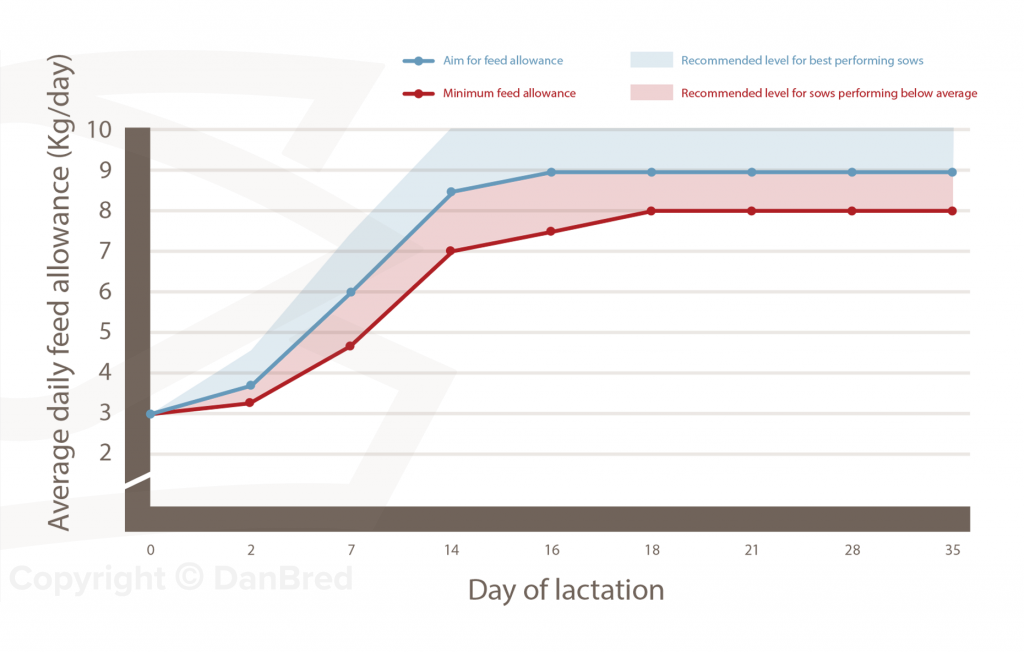
Maximum feed allowance
Towards the end of the lactation period, the sow can consume more than 10 kg per day, nevertheless, it is advised to administer the feed allowance properly and take litter size into account.
At maximum milk yield around day 16, the daily requirement for body condition maintenance is between 2.4 – 2.9 kg depending on the size of the sow. As a rule of thumb, an additional 0.47 kg is needed per piglet in the litter.
A sow average size nursing eight piglets should be allowed 6.5 kg of feed per day at maximum milk yield, whereas an average-size sow nursing 14 piglets will need as much as 9.3 kg per day at maximum milk yield.
When adjusting the feed allowance:
- Pay attention to the body condition of each sow.
- You can restrict fat sows to 8 kg per day to reduce their body condition score.
- Keep gilts at 8 kg per day, but adjust for litter size if they are gilts nursing +12 piglets
- Keep average-sized sows at 9 kg per day
- Allow sows with a low body condition score up to 10.5 kg feed per day
- Maximum feed allowance is reached around lactation day 16.
- Keep attention to the appetite of the sows, and make sure, that the feed intake does not decrease in the last week of lactation.
Feeding hygiene
Hygiene around feeding can play a significant role in optimising the feed intake and thereby milk yield in sows.
Emptying and cleaning the feed troughs before feeding will not only reduce bacterial growth but will encourage the sows to eat the full ration given. If a sow consistently leaves feed, look into hygiene and ultimately adjust the ration to avoid unnecessary feed wastage.
|
|
|

